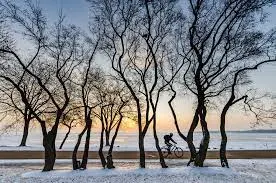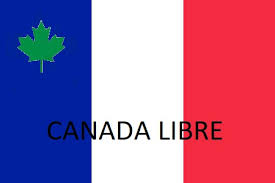UPPER-GATINEAU: LAND OF FLYING CANOES AND DANCING TREES...
Hydrographic map of
the Ottawa River (la grande rivière des Outaouais), an early water-road
connecting the Montréal archipelago with the Great Lakes region (long before
there were land-roads and freeways in Canada or the United States), including
the main sub-river, that is the Gatineau River (the one going straight south in
the direction of the present city of the same name, where it meet with the
Ottawa River, right in front of the city Ottawa). It is important to remember
that travel upriver from Montréal through the Upper Saint-Laurent was
dangerous (and often simply impossible) because of the existence of the
powerful Iroquois confederacy nearby, in what is now Upper New York State. From
the Great Lakes, by canoe, it was relatively easy, for early French explorers,
soldiers, voyageurs, priests, colons and traders,
to reach the Ohio River, the upper Mississippi River, the Missouri river, or
the small waterways leading to the Canadian Prairies. Those Great Lakes were
thus a kind of intersection (like a sort of ancient watery roundabout) for
access to the waterways existing all over the central part of the continent.
Control over that intersection enabled New France to survive and thrive for a
century and a half, despite very bad odds, quite insufficient numbers, and poor
support from a motherland that was (and still is) more of a land-power than a
sea-power.
You're herby invited
to discover a very special valley...
The
Upper Gatineau
The Gatineau valley is
located just north of the Canadian capital, Ottawa, but in the province of
Québec. It started high in the boreal forest of the western part of the
province. The river goes down a vast land covered with forests, hills and
lakes, created by the movements of glaciers in a very long ago past. Nobody
remembers the first individuals, families and clans that used the river and its
tributaries. The indigenous nation that now inhabits those parts, the
Algonquins, came from the west, according to all available evidence and spread
in a westerly fashion through the last millennias, to the Upper Great Lakes and
adjacent areas to the west. All those nations (Algonquins, Mississaugas,
Nippissings, Outaouais, Ojibways) all share the same name (Anishinabeg) and
speaks a closely related tongue, besides using the ubiquitous birchbark canoe.
Then came the French,
the explorers first, led by Samuel de Champlain, en route to Huronia, followed
by traders, soldiers, settlers, Jesuits, etc. They used the rivers, especially
the Ottawa and the Gatineau, to travel back and forth, here and there, to and
from the Great Lakes, Hudson Bay, the Prairies, the Mississipi, the Illinois
Country, la Louisiane, the Missouri lands, etc., and didn't left
much of a permanent presence.
The very first white
settlers to live near the mouth of the Gatineau, surprisingly enough, were not
Canadian, but the New Englanders brought by Philemon Wright, the founder of the
first permanent settlement, Hull, now a district of a much larger city,
Gatineau. They were later joined by French-Canadians and Irish people, and also
by the original inhabitants of that part of Canada, an Algonquin band that
sought refuge near Montréal and went back to its ancestral lands in the first
part of the XIXth century, under the leadership of Antoine Pakinawatik.
At the very same time,
European settlers, French-Canadians mainly, but also Irish in a smaller way,
were in the process of creating new agricultural lands all along the
lower reaches of the Gatineau valley, clearing the forests, removing stumps (with
the help of horses teams), creating fields where timberland used to reign
supreme, starting from the south, near Hull, going north slowly, one parish at
the time, with the most northerly village being Baskatong, now replaced by an artificial
reservoir but then at the very apex of a colonization axis that took almost a
month to travel from south to north in horse-drawn carts. At that time, the
population of the valley was essentially made up of three cultures: the
Algonquin, the French and the Irish.
Those villages that
sprang to life were divided in three regions: the Lower Gatineau Valley (la
Basse-Gatineau), from Hull to Low, the Medium Gatineau Valley (la
Moyenne-Gatineau), from Low to Gracefield, and the Upper Gatineau Valley (la
Haute-Gatineau), from Gracefield to Baskatong, with the main settlement and
local capital (Maniwaki, dubbed la Reine de la Gatineau) situated
about midway between those last two villages. The whole agricultural settlement
axis stopped at Baskatong (that was before the building of the Mercier dam, the
creation of the reservoir, and the evacuation of the French-Canadians
inhabitants of Baskatong to the nxt-to-last village -Grand-Remous-, and of the
Algonquins inhabitants to the lands of the Kitigan-Zibi and Rapid-Lake bands of
that nation), the upper reaches of the Gatineau river being left to private
logging companies.
Flying
canoes
For a long time, the
villagers being quite poor, and life, quite harsh, it was necessary to make
ends meet. So, each winter, after all work had cease on the fields,
snow-covered and forlorn, the men will leave their farms to go working in
shanties located deep in the boreal forests, cutting trees for those logging
companies, eating huge quantities of food, and longing for their families left
back home. It is said that longing was deep enough and painful enough to push
some habitants to make a pact with the Devil Himself... The oat
was simple: the Devil will transport the woodsmen in a canoe to their families
and their village, at the condition that they're not late to go back to the
shanties by the same mean, to the risk of giving their immortal souls to their
new pal, the Guardian of Hell.
That took place a long
time ago, in the semi-legendary era of the Chasse-Galerie, a
difficult-to-translate expression that designate a quite important part of the
local folklore. It was at around the same time that the Jos Montferrand and
other larger than life bûcherons and woodsmen became
folk-heroes. At that time, the canoes were said to be able to fly through
the sky, from forest shanties to the agricultural villages, not by themselves,
of course, but with the help of the Devil, of course. Is it something that was
made up by our ancestors? It's possible, but who knows? Come to think of it, if
we're able to walk on the Moon, we may be able to fly high in canoes, amid the
birds, and among the whiteness of the clouds, especially if the Devil is
involved... Why not?
Dancing
trees
As fot the dancing
trees, I must truthfully admit that contrary to the Chasse-Galerie,
they are not specific to the Upper-Gatineau valley. All forests are made up of
dancing trees, to be honest about it. Worse, each and every tree is able to
dance, and dancing is what it does, if at its own speed, a speed too slow for
us to notice the whole thing.
All members of the
animal kingdoms are mobile and able to move. It's the same thing for members of
the vegetal kingdom, it's simply that they live in a quite-slower-than-us
universe. A tree, for instance, will move and transform itself all through its
existence. More specifically, it will transition and transform itself all
through its existence, both temporally and spatially. Through time-space, it
will start as a small kernel of a being, and grow slowly, every year, to reach
eventually, usually, a much large and impressive size. Its roots will plunge
deeply into the ground, its branches will reach always higher, while its trunk
will enlarge a bit at a time, concentric circle by concentric circle.
All that, of course,
takes place slowly, much too slowly for us to be able to see it. Thus, it is
true that trees dances, it is just that our metabolism is too fast, our
attention span is too short, and our thoughts are too fleeting. We think in
seconds and minutes, while trees operate differently, in terms of months,
years, decades, and centuries.
A
Mystical Land
I'm just an old man,
by now, preparing to die in a few years. But still, I just can't help enjoying
the idea of having been born and having grown up in of such a mystical place, a
valley where canoes flies, trees dances, Algonquins lives, and life goes on,
from one marvel to another, in the land of ice-melting springtime, searing hot
summers, rainy and sad autumn, and minus 40 degrees winters.
...a
land that will always remain the legendary kingdom of the Gatineau...






Commentaires
Enregistrer un commentaire
Bonjour, tous les commentaires sont acceptés, dans la mesure où ils sont d'ordre professionnel. Insulteurs s'abstenir...